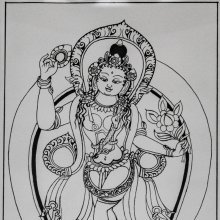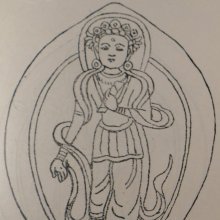Vishnukanta, Viṣṇukānta, Vishnu-kanta, Viṣṇukāntā, Vishnukamta: 7 definitions
Introduction:
Vishnukanta means something in Buddhism, Pali, Hinduism, Sanskrit, biology. If you want to know the exact meaning, history, etymology or English translation of this term then check out the descriptions on this page. Add your comment or reference to a book if you want to contribute to this summary article.
The Sanskrit terms Viṣṇukānta and Viṣṇukāntā can be transliterated into English as Visnukanta or Vishnukanta, using the IAST transliteration scheme (?).
Images (photo gallery)
In Hinduism
Shilpashastra (iconography)
Source: Wisdom Library: Śilpa-śāstraViṣṇukānta (विष्णुकान्त, “octagonal”) refers to a classification of bhittipādas, which refers to the walls of a temple.

Shilpashastra (शिल्पशास्त्र, śilpaśāstra) represents the ancient Indian science (shastra) of creative arts (shilpa) such as sculpture, iconography and painting. Closely related to Vastushastra (architecture), they often share the same literature.
Vastushastra (architecture)
Source: Wisdom Library: Vāstu-śāstra1) Viṣṇukānta (विष्णुकान्त) refers to a variety of prāsāda (‘superstructure’, or, upper storey of any building), according to the Mayamata (5th-century guidebook on Dravidian architecture). It is part of the Dvitala (two-storey) group of prāsādas.
The Viṣṇukānta variety has the following specifications and decorative motif components:
Number of talas (levels): 2;
Shape of grīva (neck) and śikhara (head): Octagonal
Number of mahānāsis: 4;
2) Viṣṇukānta (विष्णुकान्त) refers to a type of pillar (stambha). It is an eight-sided shaft. Its description is found in texts such as Mayamata (verse 15.13), Mānasāra (verse 15.10), Kāśyapaśilpa (verse 8.10), Śilparatna (verse 21.58), Īśānaśivagurudevapaddati (verse 31.11) and Kāmikāgama (verse 53.17).
Source: Shodhganga: Temples of Salem region Up to 1336 ADViṣṇukānta (विष्णुकान्त).—A type of bhittipāda, or “pilaster”;—This type of shaft possesses a carved cubical base. Above this, the shaft is made octagonal up to the bottom of the phalaka. Because the shaft is made octagonal, the upper comers of the base are decorated with patra decoration. The octagonal shaft, like the brahmakāntha type, contains vase, kumbha, maṇḍi and phalaka. The viṣṇukānta-bhittipādas are generally attractive in their form because of the tastefiil decorative carvings made on them. The base is relieved with vallimaṇḍala and other floral designs.
Source: OpenEdition books: Architectural terms contained in Ajitāgama and RauravāgamaViṣṇukānta (विष्णुकान्त) refers to “n. of a type of pillar § 3.22.”.—(For paragraphs cf. Les enseignements architecturaux de l'Ajitāgama et du Rauravāgama by Bruno Dagens)

Vastushastra (वास्तुशास्त्र, vāstuśāstra) refers to the ancient Indian science (shastra) of architecture (vastu), dealing with topics such architecture, sculpture, town-building, fort building and various other constructions. Vastu also deals with the philosophy of the architectural relation with the cosmic universe.
In Buddhism
Tibetan Buddhism (Vajrayana or tantric Buddhism)
Source: archive.org: The Indian Buddhist IconographyViṣṇukāntā (विष्णुकान्ता) or Viṣṇukāntālokeśvara refers to number 99 of the 108 forms of Avalokiteśvara found in the Machhandar Vahal (Kathmanu, Nepal). [Machhandar or Machandar is another name for for Matsyendra.].
Accordingly,—
“Viṣṇukāntā again is identical with [Piṇḍapātra Lokeśvara] in all respects, except that here the god displays the Varada mudrā with his right hand and the book against his chest in his left.—Piṇḍapātra Lokeśvara is one-faced and two-armed and stands on a lotus. He holds the Piṇḍapātra (the bowl) in his two hands near the navel”.
The names of the 108 deities [viz., Viṣṇukāntā] possbily originate from a Tantra included in the Kagyur which is named “the 108 names of Avalokiteshvara”, however it is not yet certain that this is the source for the Nepali descriptions. Tibetan Buddhism includes schools such as Nyingma, Kadampa, Kagyu and Gelug. Their primary canon of literature is divided in two broad categories: The Kangyur, which consists of Buddha’s words, and the Tengyur, which includes commentaries from various sources. Esotericism and tantra techniques (vajrayāna) are collected indepently.
Biology (plants and animals)
Source: Google Books: CRC World Dictionary (Regional names)Vishnukanta in India is the name of a plant defined with Evolvulus alsinoides in various botanical sources. This page contains potential references in Ayurveda, modern medicine, and other folk traditions or local practices It has the synonym Convolvulus valerianoides Blanco (among others).
Example references for further research on medicinal uses or toxicity (see latin names for full list):
· London Journal of Botany (1846)
· Systema Vegetabilium ed. 15 (1820)
· Prodromus Systematis Naturalis Regni Vegetabilis (DC.) (1845)
· Encyclopédie Méthodique, Botanique (Lamarck) (1789)
· Prodr. (Swartz) (1788)
· Icones plantarum formosanarum nec non et contributiones ad floram formosanam. (1925)
If you are looking for specific details regarding Vishnukanta, for example extract dosage, diet and recipes, health benefits, side effects, pregnancy safety, chemical composition, have a look at these references.

This sections includes definitions from the five kingdoms of living things: Animals, Plants, Fungi, Protists and Monera. It will include both the official binomial nomenclature (scientific names usually in Latin) as well as regional spellings and variants.
Languages of India and abroad
Kannada-English dictionary
Source: Alar: Kannada-English corpusViṣṇukāṃta (ವಿಷ್ಣುಕಾಂತ):—
1) [noun] (archit.) a class of four-storeyed buildings.
2) [noun] (archit.) an octagonal column with eight minor pillars.
3) [noun] (archit.) a gate-house with sixteen towers.
4) [noun] (archit.) a kind of phallus (linga).
5) [noun] (archit.) a kind of ornament or jewel.
Kannada is a Dravidian language (as opposed to the Indo-European language family) mainly spoken in the southwestern region of India.
See also (Relevant definitions)
Partial matches: Vishnu, Kanta.
Starts with: Vishnukantalokeshvara.
Full-text: Vishnukantalokeshvara, Rudrakanta, Varadaraja.
Relevant text
Search found 7 books and stories containing Vishnukanta, Viṣṇukānta, Vishnu-kanta, Viṣṇu-kānta, Visnu-kanta, Visnukanta, Viṣṇukāntā, Vishnukamta, Viṣṇukāṃta, Visnukamta; (plurals include: Vishnukantas, Viṣṇukāntas, kantas, kāntas, Visnukantas, Viṣṇukāntās, Vishnukamtas, Viṣṇukāṃtas, Visnukamtas). You can also click to the full overview containing English textual excerpts. Below are direct links for the most relevant articles:
The Indian Buddhist Iconography (by Benoytosh Bhattachacharyya)
Temples of Munnur (Historical Study) (by R. Muthuraman)
Dwarf Gopura < [Chapter 4]
Vastu-shastra (5): Temple Architecture (by D. N. Shukla)
Vastu-shastra (3): House Architecture (by D. N. Shukla)
Vastu-shastra (1): Canons of Architecture (by D. N. Shukla)
(vii.c) Śilparatna (Temple-architecture—Chapters 14-43) < [Chapter 5 - Study of Hindu Science of Architecture]
Manasara (English translation) (by Prasanna Kumar Acharya)

